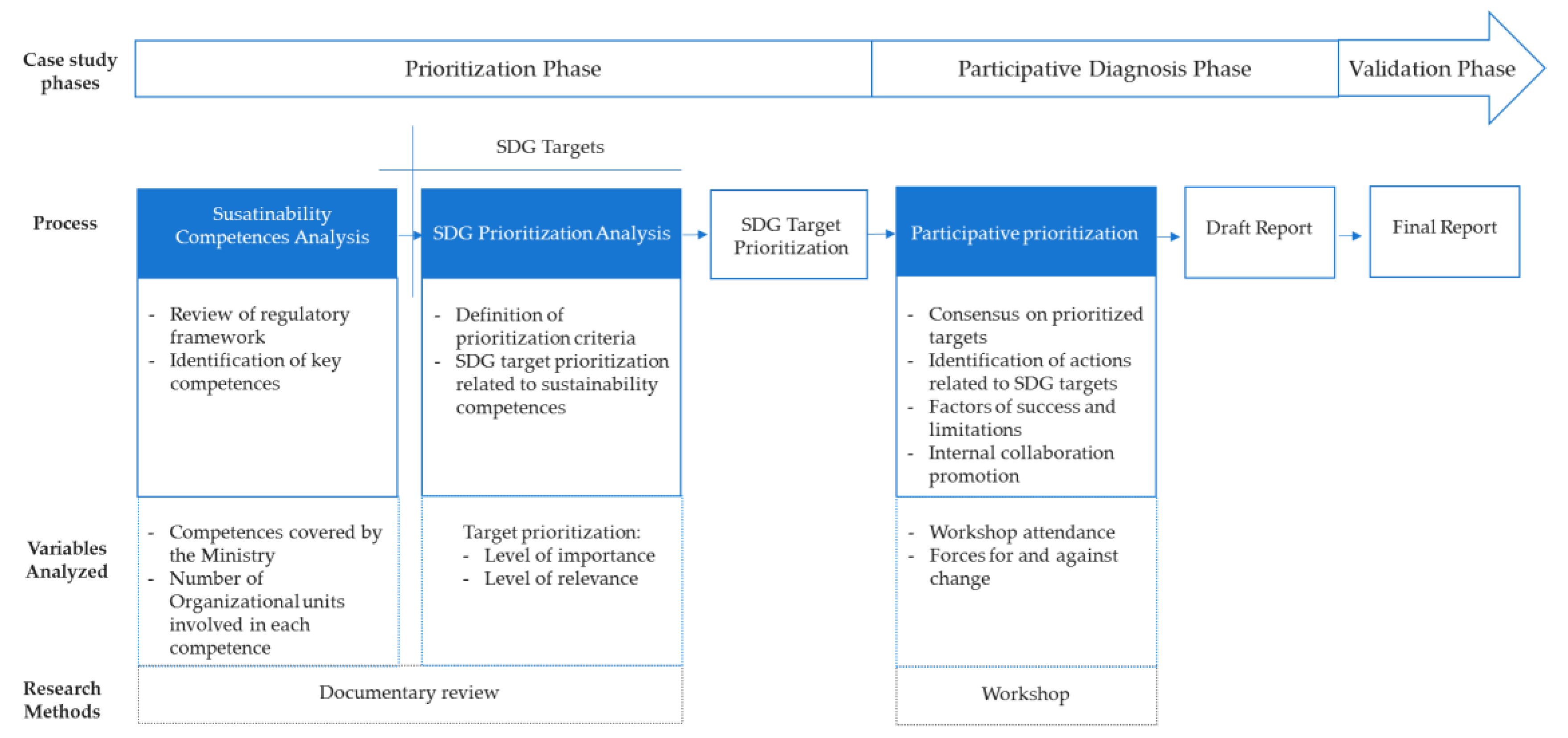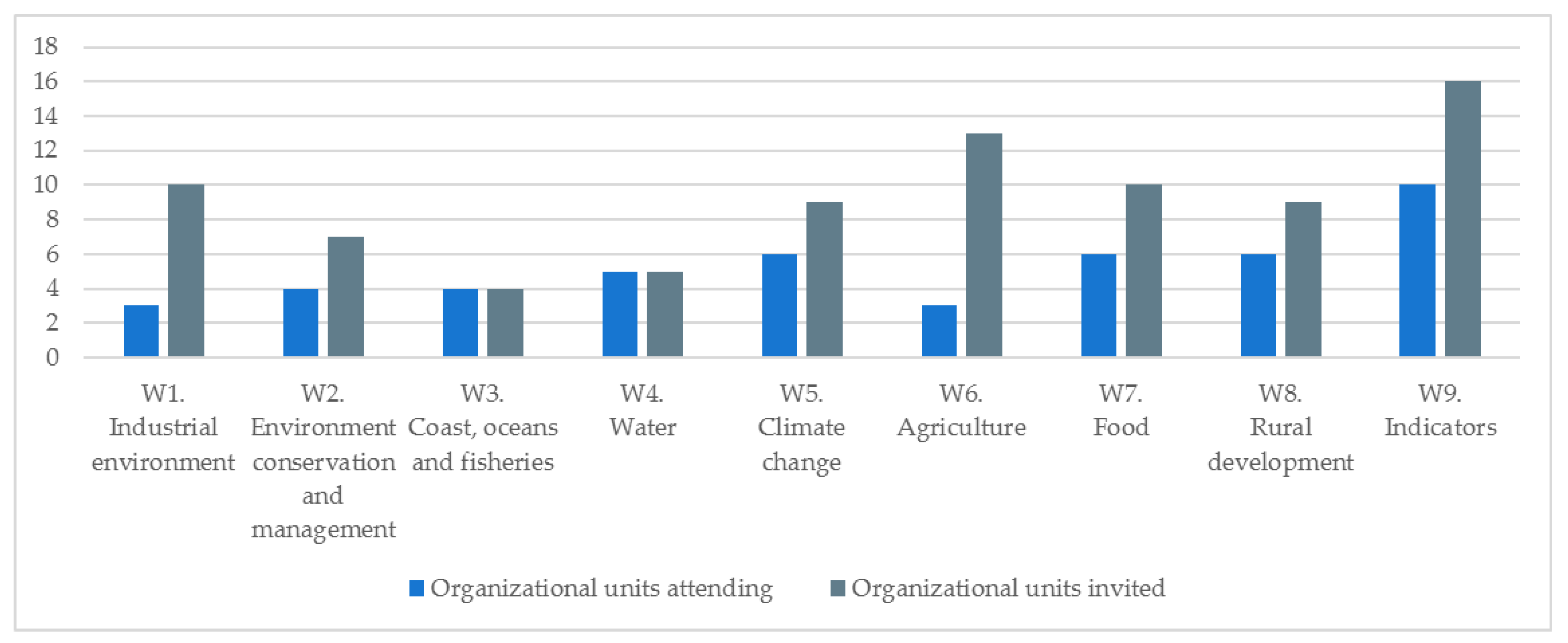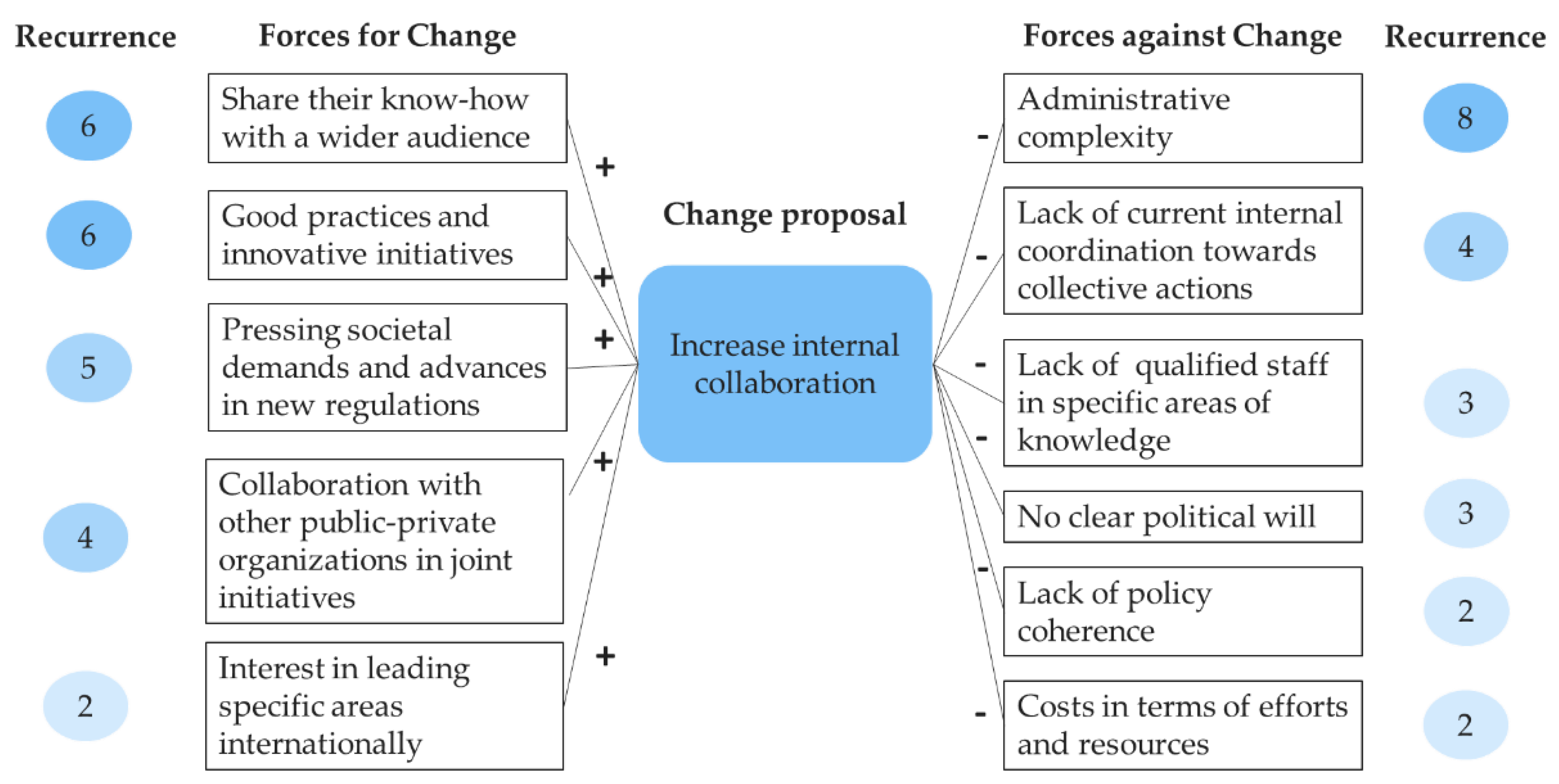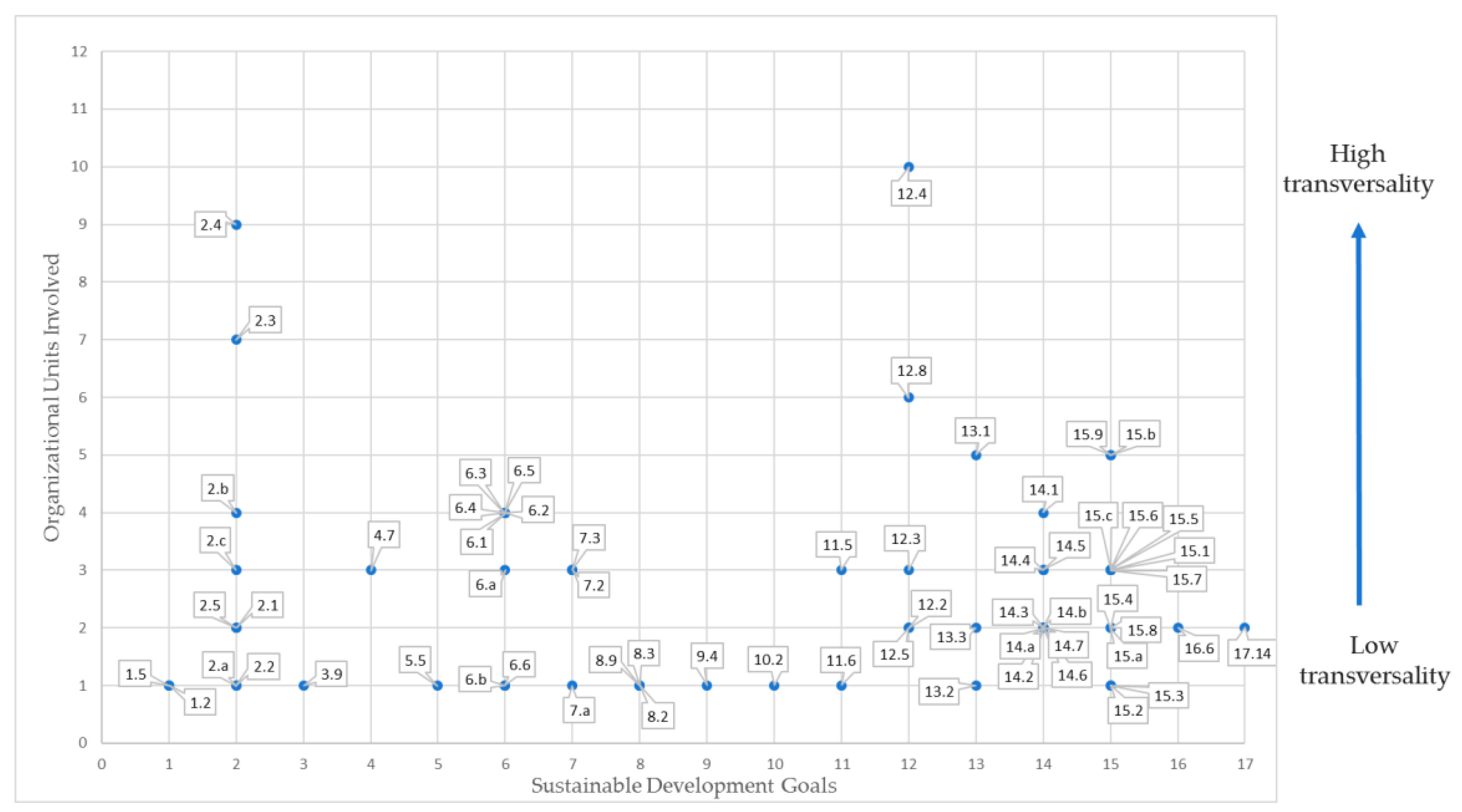Introducing an Organizational Perspective in SDG Implementation in the Public Sector in Spain: The Case of the Former Ministry of Agriculture, Fisheries, Food and Environment
Abstract
1. Introduction
2. Theoretical Overview
3. Research Approach
3.1. Research Methodology
3.2. Context of the Case Study
4. Results
4.1. Sustainability Competences Analysis
4.2. SDG Prioritization Analysis
4.3. Organizational Unit Participation in the Workshops
4.4. Forces of Change Identified during the Workshops
5. Discussion
5.1. Need for Internal Collaboration and Coordination Approaches
5.2. Readiness for Change
6. Limitations, Further Research and Conclusions
6.1. Limitations and Further Research
6.2. Concluding Remarks
Author Contributions
Funding
Acknowledgments
Conflicts of Interest
Appendix A
| Meeting | Date | Thematic | SDG Addressed | Participants |
|---|---|---|---|---|
| 1 | 11 November 2016 | Industrial environment | SDG 9, SDG 11 | 13 |
| 2 | 15 November 2016 | Environment conservation and management | SDG 15 | 10 |
| 3 | 17 November 2016 | Coast, oceans and fisheries | SDG 14 | 17 |
| 4 | 23 November 2016 | Water | SDG 6 | 8 |
| 5 | 24 November 2016 | Climate change | SDG 13, SDG 7 | 15 |
| 6 | 29 November 2016 | Agriculture | SDG 2, SDG 12 | 12 |
| 7 | 1 December 2016 | Food | SDG 2 | 8 |
| 8 | 3 December 2016 | Rural development | SDG 5, SDG 8, SDG 10, SDG 17 | 11 |
| 9 | 7 February 2017 | Indicators | SDG indicators | 18 |
| Time | Activity | Participants’ Role |
|---|---|---|
| 30 min | Introduction to the workshop and the SDGs to be addressed | Listening to the presentation |
| 15 min | Analysis of actions related to specific SDGs | Individual work on filling out a template |
| 30 min | Collection of actions and validation of SDG prioritization | Presenting individual work and discussing in groups |
| 30 min | Analysis of drivers and barriers to achieve the specific SDGs | Group work on filling out post-its and commenting their perspective |
| 20 min | Sharing of group outputs | Presenting group outputs to all participants |
| 5 min | Conclusions | Listening to main workshop conclusions |
| Ministry | Secretariats (Superior Organizational Units) | Directorates-General (Organizational Units) |
|---|---|---|
| Ministry of Agriculture, Fisheries, Food and Environment | Cabinet Office | |
| National Parks | ||
| Secretariat of State for the Environment | Spanish Climate Change Office (OECC) | |
| Quality and Environmental and Natural Environment Assessment | ||
| Coast and Sea Sustainability | ||
| Water | ||
| State Meteorological Agency (AEMET) | ||
| Secretariat of Agriculture and Fisheries, Food and Environment | Services | |
| Technical General Secretary | ||
| General Secretariat of Agriculture and Food | Agricultural Productions and Markets | |
| Health of Agricultural Production | ||
| Rural Development and Forest Policy | ||
| Food Industry | ||
| Agricultural Guarantee Fund (FEGA) | ||
| General Secretariat for Fisheries | Fishery Resources and Aquaculture | |
| Fisheries ordinance |
References
- UNDP Global Centre for Public Service Excellence. Annual Report. 2016. Available online: https://www.undp.org/content/dam/undp/library/capacity-development/English/Singapore%20Centre/2016_AnnualReport_GCPSE.pdf (accessed on 10 June 2020).
- Jomo, K.S.; Chowdhury, A.; Sharma, K.; Platz, D. Public-Private Partnerships and the 2030 Agenda for Sustainable Development: Fit for Purpose? UN Dep. Econ. Soc. Aff. 2016. [Google Scholar] [CrossRef]
- Whaites, A. Achieving the Impossible: Can We Be SDG 16 Believers? GovNet Backgr. Pap. 2016, 2, 1–14. [Google Scholar]
- Bouckaert, D.G.; Loretan, R.; Troupin, D.S. Public Administration and the Sustainable Development Goals. Int. Inst. Adm. Sci. 2016, 1–8. [Google Scholar]
- Moreno-Serna, J.; Sánchez-Chaparro, T.; Mazorra, J.; Arzamendi, A.; Stott, L.; Mataix, C. Transformational Collaboration for the SDGs: The Alianza Shire’s Work to Provide Energy Access in Refugee Camps and Host Communities. Sustainability 2020, 12, 539. [Google Scholar] [CrossRef]
- Stott, L.; Scoppetta, A. Alianzas Para Los Objetivos: Más Allá Del ODS 17. Rev. Diecisiete 2020, 2, 29–38. [Google Scholar] [CrossRef]
- Allen, C.; Metternicht, G.; Wiedmann, T. Initial Progress in Implementing the Sustainable Development Goals (SDGs): A Review of Evidence from Countries. Sustain. Sci. 2018, 13, 1453–1467. [Google Scholar] [CrossRef]
- Grainger-Brown, J.; Malekpour, S. Implementing the Sustainable Development Goals: A Review of Strategic Tools and Frameworks Available to Organisations. Sustainability 2019, 11, 1381. [Google Scholar] [CrossRef]
- Persson, Å.; Weitz, N.; Nilsson, M. Follow-up and Review of the Sustainable Development Goals: Alignment vs. Internalization. Rev. Eur. Comp. Int. Environ. Law 2016, 25, 59–68. [Google Scholar] [CrossRef]
- Allen, C.; Metternicht, G.; Wiedmann, T. Prioritising SDG Targets: Assessing Baselines, Gaps and Interlinkages. Sustain. Sci. 2019, 14, 421–438. [Google Scholar] [CrossRef]
- Ranängen, H.; Cöster, M.; Isaksson, R.; Garvare, R. From Global Goals and Planetary Boundaries to Public Governance—A Framework for Prioritizing Organizational Sustainability Activities. Sustainability 2018, 10, 2741. [Google Scholar] [CrossRef]
- Stafford-Smith, M.; Griggs, D.; Gaffney, O.; Ullah, F.; Reyers, B.; Kanie, N.; Stigson, B.; Shrivastava, P.; Leach, M.; O’Connell, D. Integration: The Key to Implementing the Sustainable Development Goals. Sustain. Sci. 2017, 12, 911–919. [Google Scholar] [CrossRef] [PubMed]
- Forestier, O.; Kim, R.E. Cherry-Picking the Sustainable Development Goals: Goal Prioritization by National Governments and Implications for Global Governance. Sustain. Dev. 2020. [Google Scholar] [CrossRef]
- Peters, B.G. Managing Horizontal Government: The Politics of Co-Ordination. Public Adm. 1998, 76, 295–311. [Google Scholar] [CrossRef]
- Roberts, N. Wicked Problems and Network Approaches to Resolution. Int. Public Manag. Rev. 2000, 1, 1–19. [Google Scholar]
- Tosun, J.; Leininger, J. Governing the Interlinkages between the Sustainable Development Goals: Approaches to Attain Policy Integration. Glob. Chall. 2017, 1, 1700036. [Google Scholar] [CrossRef]
- Blanc, D.L. Towards Integration at Last? The Sustainable Development Goals as a Network of Targets. Sustain. Dev. 2015, 23, 176–187. [Google Scholar] [CrossRef]
- Coopman, A.; Osborn, D.; Ullah, F.; Auckland, E. Implementing the SDGs in an Integrated and Coherent Way. 2016. Available online: https://www.local2030.org/library/159/Seeing-the-Whole-Implementing-SDGs-in-an-Integrated-and-Coherent-Way.pdf (accessed on 20 July 2020).
- Weitz, N.; Carlsen, H.; Nilsson, M.; Skånberg, K. Towards Systemic and Contextual Priority Setting for Implementing the 2030 Agenda. Sustain. Sci. 2018, 13, 531–548. [Google Scholar] [CrossRef]
- Breuer, A.; Janetschek, H.; Malerba, D. Translating Sustainable Development Goal (SDG) Interdependencies into Policy Advice. Sustainability 2019, 11, 2092. [Google Scholar] [CrossRef]
- Verhoest, K.; Lægreid, P. Organizing Public Sector Agencies: Challenges and Reflections. In Governance of Public Sector Organizations; Palgrave Macmillan: London, UK, 2010; pp. 276–297. [Google Scholar]
- Ryan, C.; Walsh, P. Collaboration of Public Sector Agencies: Reporting and Accountability Challenges. Int. J. Public Sect. Manag. 2004, 17, 621–631. [Google Scholar] [CrossRef]
- Kavanagh, D.; Richards, D. Departmentalism and Joined-up Government. Parliam. Aff. 2001, 54, 1–18. [Google Scholar] [CrossRef]
- Currie, W.L. Revisiting Management Innovation and Change Programmes: Strategic Vision or Tunnel Vision? Omega 1999, 27, 647–660. [Google Scholar] [CrossRef]
- Bögel, P.; Pereverza, K.; Upham, P.; Kordas, O. Linking Socio-Technical Transition Studies and Organisational Change Management: Steps towards an Integrative, Multi-Scale Heuristic. J. Clean. Prod. 2019, 232, 359–368. [Google Scholar] [CrossRef]
- Klapper, R.; Berg, L.; Upham, P. Probing Alignment of Personal and Organisational Values for Sustainability: An Assessment of Barrett’s Organisational Consciousness Model. Sustainability 2020, 12, 7584. [Google Scholar] [CrossRef]
- Domingues, A.R.; Lozano, R.; Ceulemans, K.; Ramos, T.B. Sustainability Reporting in Public Sector Organisations: Exploring the Relation between the Reporting Process and Organisational Change Management for Sustainability. J. Environ. Manag. 2017, 192, 292–301. [Google Scholar] [CrossRef] [PubMed]
- Lozano, R.; Garcia, I. Scrutinizing Sustainability Change and Its Institutionalization in Organizations. Front. Sustain. 2020. [Google Scholar] [CrossRef]
- Calabrese, A.; Costa, R.; Ghiron, N.L.; Menichini, T. Materiality Analysis in Sustainability Reporting: A Method for Making It Work in Practice. Eur. J. Sustain. Dev. 2017, 6, 439. [Google Scholar] [CrossRef]
- Alonso-Almeida, M.D.M.; Llach, J.; Marimon, F. A Closer Look at the ‘Global Reporting Initiative’ Sustainability Reporting as a Tool to Implement Environmental and Social Policies: A Worldwide Sector Analysis. Corp. Soc. Responsib. Environ. Manag. 2014, 21, 318–335. [Google Scholar] [CrossRef]
- SDG Compass. A Guide for Business Action to Advance the Sustainable Development Goals. Available online: https://sdgcompass.org/ (accessed on 17 July 2020).
- The Poverty Footprint. A People-centred Approach to Assessing Business Impacts on Sustainable Development UN Global Compact. Available online: https://www.unglobalcompact.org/library/3131 (accessed on 17 July 2020).
- Lozano, R. Analysing the Use of Tools, Initiatives, and Approaches to Promote Sustainability in Corporations. Corp. Soc. Responsib. Environ. Manag. 2020, 27, 982–998. [Google Scholar] [CrossRef]
- Armenakis, A.A.; Harris, S.G. Crafting a Change Message to Create Transformational Readiness. J. Organ. Chang. Manag. 2002, 15, 169–183. [Google Scholar] [CrossRef]
- Lewin, K. Field Theory in Social Science: Selected Theoretical Papers; Dorwin, C., Ed.; Harpers: Oxford, UK, 1951. [Google Scholar]
- Gobierno de España. Plan de Acción para la Implementación de la Agenda 2030: Hacia una Estrategia Española de Desarrollo Sostenible. 2018. Available online: https://www.cooperacionespanola.es/sites/default/files/plan_de_accion_para_la_implementacion_de_la_agenda_2030.pdf (accessed on 6 July 2020).
- Richards, D.; Smith, M.J. The Tensions of Political Control and Administrative Autonomy: From NPM to a Reconstituted Westminster Model. In Autonomy and Regulation: Coping with Agencies in the Modern State, 1st ed.; Christensen, T., Lægreid, T., Eds.; Edward Elgar: Cheltenham, UK, 2006; Volume 1, pp. 181–200. [Google Scholar]
- Webb, A. Coordination: A Problem in Public Sector Management. Policy Politics 1991, 19, 229–242. [Google Scholar] [CrossRef]
- Challis, L.; Fuller, S.; Henwood, M.; Klein, R.; Plowden, W.; Webb, A.; Whittingham, P.; Wistow, G. Investigating Policy Coordination: Issues and Hypotheses; SAGE: London, UK, 1994. [Google Scholar]
- Christensen, T.; Lægreid, P. The Whole-of-Government Approach to Public Sector Reform. Public Adm. Rev. 2007, 67, 1059–1066. [Google Scholar] [CrossRef]
- Weber, E.P.; Khademian, A.M. Wicked Problems, Knowledge Challenges, and Collaborative Capacity Builders in Network Settings. Public Adm. Rev. 2008, 68, 334–349. [Google Scholar] [CrossRef]
- Rittel, H.W.; Webber, M.M. Dilemmas in a General Theory of Planning. Policy Sci. 1973, 4, 155–169. [Google Scholar] [CrossRef]
- Head, B. Wicked Problems in Public Policy. Public Policy 2008, 3, 101. [Google Scholar]
- United Nations General Assembly. Transforming Our World: The 2030 Agenda for Sustainable Development. A/RES/70/1. 2015. Available online: https://www.un.org/ga/search/view_doc.asp?symbol=A/RES/70/1&Lang=E. (accessed on 15 October 2020).
- Sachs, J.D.; Schmidt-Traub, G.; Mazzucato, M.; Messner, D.; Nakicenovic, N.; Rockström, J. Six Transformations to Achieve the Sustainable Development Goals. Nat. Sustain. 2019, 2, 805–814. [Google Scholar] [CrossRef]
- Alonso, J.A.; Ayuso, A. Acercar los Objetivos de Desarrollo Sostenible a la Ciudadanía: El Compromiso de Europa con la Agenda 2030; CIDOB: Barcelona, Spain, 2017. [Google Scholar]
- Granados, F.J.; Noferini, A. Subnational Governments and the 2030 Agenda: Strengthening Policy Effectiveness and Legitimacy with the Localization of the Sustainable Development Goals; Institut Barcelona d’Estudis Internacionals: Barcelona, Spain, 2019; 94p. [Google Scholar]
- Thompson, G. Markets, Hierarchies and Networks: The Coordination of Social Life; Sage Publications: London, UK, 1991. [Google Scholar]
- Provan, K.G.; Kenis, P. Modes of Network Governance: Structure, Management, and Effectiveness. J. Public Adm. Res. Theory 2008, 18, 229–252. [Google Scholar] [CrossRef]
- Meuleman, L. Conclusions: Metagovernance as Framework for SDG Implementation. In Metagovernance for Sustainability; Routledge: Abingdon, UK, 2018; pp. 293–312. [Google Scholar]
- Christopoulos, S.; Horvath, B.; Kull, M. Advancing the Governance of Cross-Sectoral Policies for Sustainable Development: A Metagovernance Perspective. Public Adm. Dev. 2012, 32, 305–323. [Google Scholar] [CrossRef]
- Head, B.W.; Alford, J. Wicked Problems: Implications for Public Policy and Management. Adm. Soc. 2015, 47, 711–739. [Google Scholar] [CrossRef]
- Fleishman, R. To Participate or Not to Participate? Incentives and Obstacles for Collaboration. In The Collaborative Public Manager: New Ideas for the Twenty-First Century, 1st ed.; O’Leary, R., Blomgren, L., Eds.; Georgetown University Press: Washington, DC, USA, 2009; pp. 31–52. [Google Scholar]
- Oreg, S. Personality, Context, and Resistance to Organizational Change. Eur. J. Work Organ. Psychol. 2006, 15, 73–101. [Google Scholar] [CrossRef]
- Ford, J.D.; Ford, L.W.; D’Amelio, A. Resistance to Change: The Rest of the Story. AMR 2008, 33, 362–377. [Google Scholar] [CrossRef]
- Kotter, J.P. Leading Change: Why Transformation Efforts Fail. IEEE Eng. Manag. Rev. 1995, 37, 59–67. [Google Scholar] [CrossRef]
- Ford, J.D.; Ford, L.W. Stop Blaming Resistance to Change and Start Using It. Organ. Dyn. 2010, 39, 24–36. [Google Scholar] [CrossRef]
- Armenakis, A.; Harris, S.G.; Feild, H.S. Paradigms in Organizational Change: Change Agent and Change Target Perspectives. In Handbook of Organizational Behavior; Golembiewski, R., Ed.; Marcel Dekker: New York, NY, USA, 1999. [Google Scholar]
- Rafferty, A.E.; Jimmieson, N.L.; Armenakis, A.A. Change Readiness: A Multilevel Review. J. Manag. 2013, 39, 110–135. [Google Scholar] [CrossRef]
- Vakola, M. Multilevel Readiness to Organizational Change: A Conceptual Approach. J. Chang. Manag. 2013, 13, 96–109. [Google Scholar] [CrossRef]
- Armenakis, A.A.; Harris, S.G.; Mossholder, K.W. Creating Readiness for Organizational Change. Hum. Relat. 1993, 46, 681–703. [Google Scholar] [CrossRef]
- Burnett, S.; Benn, J.; Pinto, A.; Parand, A.; Iskander, S.; Vincent, C. Organisational Readiness: Exploring the Preconditions for Success in Organisation-Wide Patient Safety Improvement Programmes. Qual. Saf. Health Care 2010, 19, 313–317. [Google Scholar] [CrossRef] [PubMed]
- Bernerth, J. Expanding Our Understanding of the Change Message. Hum. Resour. Dev. Rev. 2004, 3, 36–52. [Google Scholar] [CrossRef]
- Fawcett, S.E.; Magnan, G.M.; McCarter, M.W. Benefits, Barriers, and Bridges to Effective Supply Chain Management. Supply Chain Manag. Int. J. 2008, 13, 35–48. [Google Scholar] [CrossRef]
- Rasche, A. The Paradoxical Foundation of Strategic Management, 1st ed.; Physica-Verlag: Heidelberg, Germany, 2007. [Google Scholar]
- Mintzberg, H. The Strategy Concept I: Five Ps for Strategy. Calif. Manag. Rev. 1987, 30, 11–24. [Google Scholar] [CrossRef]
- Yin, R.K. The Case Study as a Serious Research Strategy. Knowledge 1981, 3, 97–114. [Google Scholar] [CrossRef]
- Galunic, D.C.; Eisenhardt, K.M. Architectural Innovation and Modular Corporate Forms. Acad. Manag. J. 2001, 44, 1229–1249. [Google Scholar] [CrossRef]
- Zelikow, P.; Allison, G. Essence of Decision: Explaining the Cuban Missile Crisis; Longman: New York, NY, USA, 1999. [Google Scholar]
- Assefa, G.; Frostell, B. Social Sustainability and Social Acceptance in Technology Assessment: A Case Study of Energy Technologies. Technol. Soc. 2007, 29, 63–78. [Google Scholar] [CrossRef]
- Dwyer, R.; Lamond, D.; Lee, K.-H. Why and How to Adopt Green Management into Business Organizations? Manag. Decis. 2009, 7. [Google Scholar] [CrossRef]
- Austin, G. Case Study and Sustainability Assessment of Bo01, Malmö, Sweden. J. Green Build. 2013, 8, 34–50. [Google Scholar] [CrossRef]
- Ike, M.; Donovan, J.D.; Topple, C.; Masli, E.K. The Process of Selecting and Prioritising Corporate Sustainability Issues: Insights for Achieving the Sustainable Development Goals. J. Clean. Prod. 2019, 236, 117661. [Google Scholar] [CrossRef]
- Eisenhardt, K.M. Building Theories from Case Study Research. AMR 1989, 14, 532–550. [Google Scholar] [CrossRef]
- Lieberman, A. Collaborative Research: Working with, Not Working On. Educ. Leadersh. 1986, 43, 28–32. [Google Scholar]
- Shani, A.B.; Mohrman, S.A.; Pasmore, W.A.; Stymne, B.; Adler, N. Handbook of Collaborative Management Research, 1st ed.; Sage Publications: Thousand Oaks, CA, USA, 2007. [Google Scholar]
- Coughlan, P.; Coghlan, D. Action Research for Operations Management. Int. J. Oper. Prod. Manag. 2002. [Google Scholar] [CrossRef]
- Zarei, M.H.; Carrasco-Gallego, R.; Ronchi, S. To Greener Pastures: An Action Research Study on the Environmental Sustainability of Humanitarian Supply Chains. Int. J. Oper. Prod. Manag. 2019, 39, 1193–1225. [Google Scholar] [CrossRef]
- Ørngreen, R.; Levinsen, K. Workshops as a Research Methodology. Electron. J. E-Learn. 2017, 15, 70–81. [Google Scholar]
- Cornwall, A.; Jewkes, R. WHAT IS PARTICIPATORY RESEARCH? Soc. Sci. Med. 1995, 41, 1667–1676. [Google Scholar] [CrossRef]
- Thomas, R.; Sargent, L.D.; Hardy, C. Managing Organizational Change: Negotiating Meaning and Power-Resistance Relations. Organ. Sci. 2011, 22, 22–41. [Google Scholar] [CrossRef]
- Miles, M.B.; Huberman, A.M. Qualitative Data Analysis: An Expanded Sourcebook; Sage Publications: Thousand Oaks, CA, USA, 1994. [Google Scholar]
- Saldaña, J. The Coding Manual for Qualitative Researchers; SAGE: London, UK, 2015. [Google Scholar]
- Ministerio de Agricultura, Pesca, Alimentación y Medio Ambiente. Jaime Haddad Subraya el Compromiso del Ministerio con el Cumplimiento de los Objetivos de Desarrollo Sostenible y las Metas de la Agenda 2030. Available online: https://www.miteco.gob.es/en/prensa/180129jhaddadjornadaagenda2030_tcm38-439794.pdf (accessed on 20 July 2020).
- Canel, M.J. Local Government in the Spanish Autonomic State. Local Gov. Stud. 1994, 20, 44–59. [Google Scholar] [CrossRef]
- Constitución Española. Boletín Oficial del Estado, 29 de Diciembre de 1978, núm. 311, pp. 29313 a 29424. Available online: https://www.boe.es/buscar/doc.php?id=BOE-A-1978-31229 (accessed on 10 July 2020).
- Börzel, T.A. From Competitive Regionalism to Cooperative Federalism: The Europeanization of the Spanish State of the Autonomies. Publius 2000, 30, 17–42. [Google Scholar] [CrossRef]
- Martos, J.A.M. La Evolución de las Competencias Compartidas. Rev. Derecho Político 2018, 101, 573–605. [Google Scholar] [CrossRef][Green Version]
- España. Real Decreto 401/2012, de 17 de Febrero, por el que se Desarrolla la Estructura Orgánica Básica del Ministerio de Agricultura, Alimentación y Medio Ambiente. Boletín Oficial del Estado núm. 42, de 18 de Febrero de 2012, Páginas 14554 a 14580. Available online: https://www.boe.es/buscar/doc.php?id=BOE-A-2012-2397 (accessed on 12 July 2020).
- España. Real Decreto 424/2016, de 11 de Noviembre, por el que se Establece la Estructura orgánica Básica de los Departamentos Ministeriales. Boletín Oficial del Estado núm. 274, de 12 de Noviembre de 2016, Páginas 78778 a 78789. Available online: https://www.boe.es/eli/es/rd/2016/11/11/424 (accessed on 12 July 2020).
- Ministerio para la Transición Ecológica y el Reto Demográfico. Reeducamar. Available online: https://www.miteco.gob.es/es/ceneam/recursos/mini-portales-tematicos/reeducamar/proyectos-programas.aspx (accessed on 9 October 2020).
- Kim, T.G.; Hornung, S.; Rousseau, D.M. Change-Supportive Employee Behavior: Antecedents and the Moderating Role of Time. J. Manag. 2011, 37, 1664–1693. [Google Scholar] [CrossRef]
- Gustafsson, J. Single Case Studies vs. Multiple Case Studies: A Comparative Study. 2017, 15. [Google Scholar]
- Baechler, J. Operationalizing “Whole-of-Government” as an Approach to State Fragility and Instability: Case Studies from Ottawa, Canada and London, United Kingdom. Ph.D. Thesis, Dalhousie University, Halifax, NS, Canada, 2016. [Google Scholar]
- Hall, N.L.; Ross, H.; Richards, R.; Barrington, D.J.; Dean, A.J.; Head, B.W.; Jagals, P.; Reid, S.; Hill, P.S. Implementing the United Nations’ Sustainable Development Goals for Water and beyond in Australia: A Proposed Systems Approach. Australas. J. Water Resour. 2018, 22, 29–38. [Google Scholar] [CrossRef]





| Sustainability Competences with One Responsible Organizational Unit | Sustainability Competences with Two Responsible Organizational Units |
|---|---|
| Sustainability training International agreements and negotiations Multilateral organizations Organic farming Agricultural trade Food industry Food quality and safety Agricultural diversity and patents Irrigation Forestry Land ownership and farm structure Sustainable rural development Territorial planning Environmental education Environmental audit and responsibility Chemical products Waste and contaminated soils Industrial environment Environmental impact assessment Air quality and noise Sustainable water management Climate change adaptation Climate change mitigation | Strategic planning and management Food chains Animal and plant health Fertilizers and phytosanitation Food production and agricultural markets Fishing and aquaculture Coastal and marine environment management Protected spaces management Biodiversity conservation Climate change awareness |
Publisher’s Note: MDPI stays neutral with regard to jurisdictional claims in published maps and institutional affiliations. |
© 2020 by the authors. Licensee MDPI, Basel, Switzerland. This article is an open access article distributed under the terms and conditions of the Creative Commons Attribution (CC BY) license (http://creativecommons.org/licenses/by/4.0/).
Share and Cite
Soberón, M.; Sánchez-Chaparro, T.; Urquijo, J.; Pereira, D. Introducing an Organizational Perspective in SDG Implementation in the Public Sector in Spain: The Case of the Former Ministry of Agriculture, Fisheries, Food and Environment. Sustainability 2020, 12, 9959. https://doi.org/10.3390/su12239959
Soberón M, Sánchez-Chaparro T, Urquijo J, Pereira D. Introducing an Organizational Perspective in SDG Implementation in the Public Sector in Spain: The Case of the Former Ministry of Agriculture, Fisheries, Food and Environment. Sustainability. 2020; 12(23):9959. https://doi.org/10.3390/su12239959
Chicago/Turabian StyleSoberón, Miguel, Teresa Sánchez-Chaparro, Julia Urquijo, and David Pereira. 2020. "Introducing an Organizational Perspective in SDG Implementation in the Public Sector in Spain: The Case of the Former Ministry of Agriculture, Fisheries, Food and Environment" Sustainability 12, no. 23: 9959. https://doi.org/10.3390/su12239959
APA StyleSoberón, M., Sánchez-Chaparro, T., Urquijo, J., & Pereira, D. (2020). Introducing an Organizational Perspective in SDG Implementation in the Public Sector in Spain: The Case of the Former Ministry of Agriculture, Fisheries, Food and Environment. Sustainability, 12(23), 9959. https://doi.org/10.3390/su12239959






